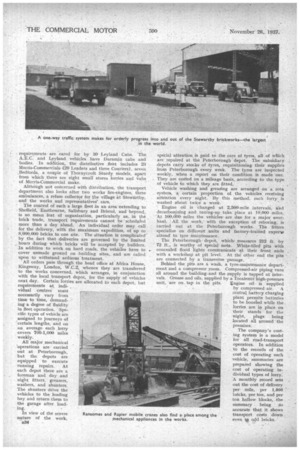SOPPLYINC MILLI
Page 16

Page 17

Page 18

If you've noticed an error in this article please click here to report it so we can fix it.
Or UPOCKS A DAY
c it possibito
LESS than two years ago, the London Brick Co., Ltd., owned no commercial vehicles. for distributive purposes, and relied upon the services of the railways, waterways Awl./ motors and hauliers for the removal of its, vast output In February, 1930, however, the company created a central transport department, and to-day it controls a fleet of 180 units. The vehicles . range in size from small vans to giant eight-wheelers and are maintained on the highly efficient lines of a big bus
organization. .
The vehicles are centred on five depots and supply transport for 27 works. The principal garage and workshop are at Peterborough, and represent the latest practice in road-trans port accommodation. A new garage has been opened at Bletchley, whilst another on similar lines, with space for about
30 vehicles, is nearing completion. at Calvert. An existing garage at Stewartby, where the largest works is located, has been broUght 'up to date, v;Philsta fifth depot has recently been
completed at Arlesley. '
Apart from the undertaking at Stewartby, there are works groups at Peterborough, WhittleSea, Bletchley; and Calvert,,
granite quarries at Nuneaton, and tileries at Hednesford and SeaHord. The Stewartby works, which is the largest in the world, is a township in itself, for it includes a model village, with schools, a club, and a' store. Forty-seven mechanical• excavators shave the gaunt clay from the pits, some of which are 80 ft. deep.
After excavation, the clay is screened and mixed, and conveyed in ground form to presses, which mould the bricks between heated dies. Slowly they pass through the kilns, reaching a temperature of 1,150 degrees C., after which they slowly cool, When the bricks leave the kilns on trollies, each of which accommodates 5,000, they are transferred to the loading bays by means of hydraulic rams.
Apart from the common brick, of which the company produces over 6,000,000 daily, there are 83 kinds of special Phorpres brick, all of which . call for urgent delivery.
The fleet which assists' in the movement of this enormous output is widely varied. There are 84 A.E.C.s; comprising 48 Monarch oilers, 30 Mammoth eight-wheelers, and six Mammoth Major six-wheelers. Some of the smaller transport
requirements are cared for by 30 Leyland Cubs. The. A.E.C. and Leyland vehicles have Duraudn cabs and bodies. In addition, the distributive fleet includes 23 Morris-Commercials (20 Leaders and three Couriers), seven Bedfords, a -couple of Thornycroft Sturdy models, apart from which there are eight small stores lorries and Vans of Morris-Commercial make. .
Although not concerned with distribution, the transport department also looks after two works fire-engines, three ambulances, a refuse collector for the village at Stewartby, and the works and representatives'. cars.
The control of such a large fleet in an area extending to Sheffield, Eastbourne, Salisbury and Bristol, and beyond, is no mean feat of organization, particularly as. in the brick trade, transport requirements cannot be •scheduled more than a day ahead. An individual order may call for the delivery, with the maximum expedition, of up to 8;000,000 bricks to one site. The situation is complicated• by the fact that deliveries are governed by the limited hours during which bricks will be accepted by builders. In addition to work on hard roads, the vehicles have to cover unmade ground on -building sites,. and are called upon to withstand arduous treatment.
All major mechanical 'operations arecarried out at Peterborough, but the depots are equipped to execute running repairs. At each depot there are a foreman and day and night Wert, greasers, washers, and shunters. The shunters drive the vehicles to the loading bay and return them to the garage after load
ing. • In view of the severe nature of the work, '834 special attention is paid to the pare of tyres, all of which are repaired at the Peterborough depot. The subsidiary depots carry stocks of tyres, requisitioning. their supplies from Peterborough every week. The tyres are inspected weekly, when a report on their condition is made out. They are costed on a mileage basis, according to the type of vehicle to which they are fitted.
Vehicle washing and greasing are arranged on a. rota system, a certain proportion of the vehicles receiving attention every night. By this method, each lorry is washed about twice a week.
" Engine oil is changed at 2,500-mile intervals, a'nd decarbonizing and tuning-up take. place at 10,000 miles. At 100400miles the vehiclesare due for a major overhaul. 'All the work,' with the exception of reboring, is Carried out at the Peterborough works. The fitters specialize on different units and factory-traiiied expert attend to tyre -Maintenance.
The Peterboroughdepot, whichmeasures 212 ft. by 72 ft., is worthy of special note. White-tiled pits with concealed florid lights communicate at their front ends • with a workshop at pit level. At the other end the pits are connected by a transverse passage, •• Behind the pits. are a wash, a tyre-maintenance depart-„' merit and a compressor room. Compressed-air piping runs all around the building.and thesupply is tapped at intervals. Grease and oils, supplied by a Tecalernithigh-pressure
unit, are on. tap in the pits. gngine oil is 'supplied
by compressed air. A . central battery charging plant permits batteries to be boosted while the, lorries are in place on their stands for the night, plugs being located all around the premises, The company's cost ing system is a model for all road-transport operators. In addition to the records of the cost of operating each vehicle, summaries are prepared showing the cost of operating individual types of lorry. A monthly record sets . out the cost of delivery per mile, per 1,000 bricks, per ton, and per ton hollow blocks. the • summary being • so accurate that it shows transport costs doWn even te odd bricks.






























